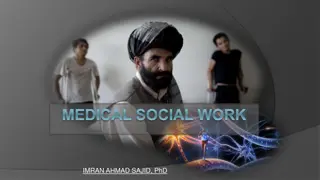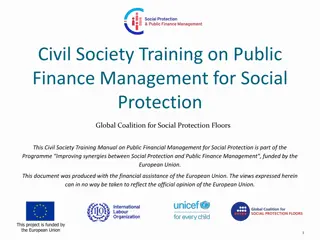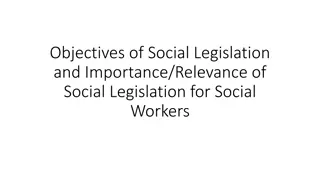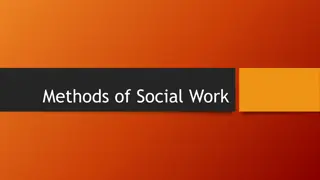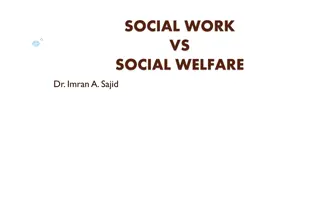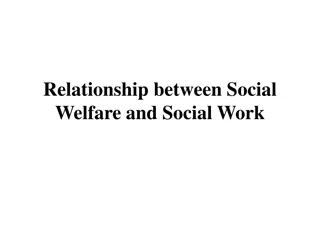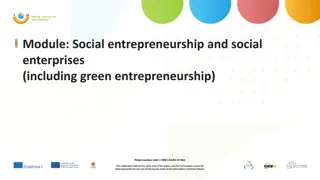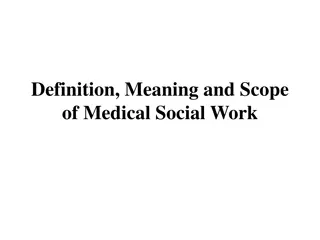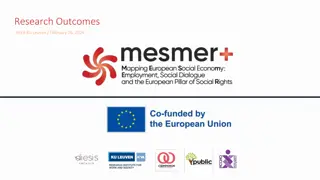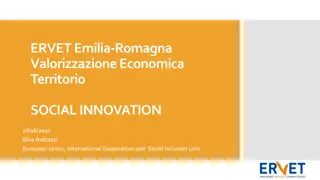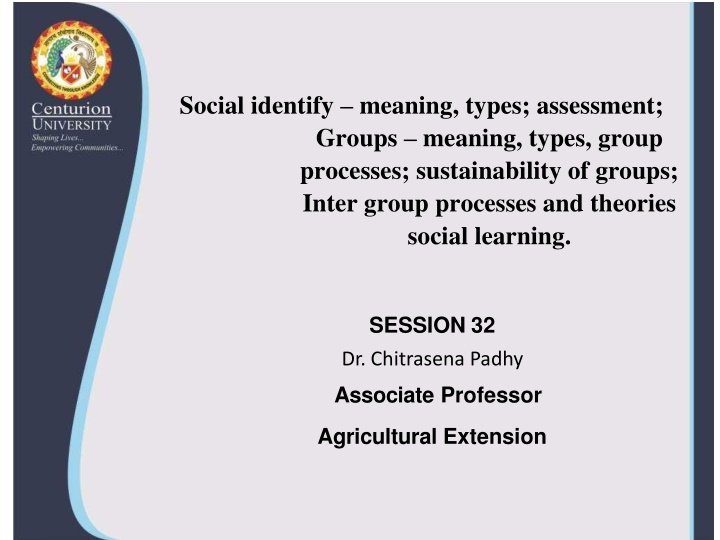
Social Identity Theory and Group Processes
Explore the origins and principles of social identity theory in psychology, focusing on how individuals perceive themselves in groups. Learn about social categorization, motivation, group processes, and the impact of group dynamics on behavior and relationships.
Download Presentation

Please find below an Image/Link to download the presentation.
The content on the website is provided AS IS for your information and personal use only. It may not be sold, licensed, or shared on other websites without obtaining consent from the author. If you encounter any issues during the download, it is possible that the publisher has removed the file from their server.
You are allowed to download the files provided on this website for personal or commercial use, subject to the condition that they are used lawfully. All files are the property of their respective owners.
The content on the website is provided AS IS for your information and personal use only. It may not be sold, licensed, or shared on other websites without obtaining consent from the author.
E N D
Presentation Transcript
Social identify meaning, types; assessment; Groups meaning, types, group processes; sustainability of groups; Inter group processes and theories social learning. SESSION 32 Dr. Chitrasena Padhy Associate Professor Agricultural Extension
Social identity theory, in social psychology, the study of the interplay between personal and social identities. Social identity theory aims to specify and predict the circumstances under which individuals think of themselves as individuals or as group members. The theory also considers the consequences of personal and social identities for individual perceptions and group behaviour.
Thus, social identity theory originated from the conviction that group membership can help people to instill meaning in social situations. Group membership helps people to define who they are and to determine how they relate to others. Social identity theory was developed as an integrative theory, as it aimed to connect cognitive processes and behavioral motivation. Initially, its main focus was on intergroup conflict and intergroup relations more broadly. For that reason, the theory was originally referred to as the social identity theory of intergroup relations.
Cognitive processes Social identity theory was developed to explain how individuals create and define their place in society. According to the theory, three psychological processes are central in that regard: social categorization, social comparison, and social identification. Motivation According to social identity theory, social behaviour is determined by the character and motivations of the person as an individual (interpersonal behaviour) as well as by the person s group membership (i.e., intergroup behaviour).
People generally prefer to maintain a positive image of the groups to which they belong. As a result of social identity processes, people are inclined to seek out positively valued traits, attitudes, and behaviours that can be seen as characteristic of their in- groups. Group process is the understanding of how groups of people come together, connect, interact, and disconnect. It can also refer to how groups perform activities or tasks together. In a workshop setting, an ideal facilitator would be professionally trained in understanding the dynamics of groups as well as a group process in order to be inclusive and effective.
In a group context, there are some people who will emerge as natural leaders, others who will be supporters, and also those who will be problem- finders/solvers. One of the dark sides of the group process is the tendency for groups to create a scapegoat within the group. A scapegoat is someone that the group decides is different from them and doesn t belong to the group.
Through thoughtful and skilful group settings, attuned group facilitators will be able to help groups to grow, be honest about their darker impulses, correct the tendency to scapegoat, and extend to a more-than-human capacity for inclusion, forgiveness, and healing. Group process refers to how an organization s members work together to get things done. Typically, organizations spend a great deal of time and energy setting and striving to reach goals but give little consideration to what is happening between and to the group s greatest resource its members.
Basic Assumptions of Group Dynamics According to Cartwright and Zander (1968), the basic assumptions are: i) the groups are inevitable (even the hermits / Sanyasis and the Hippies), ii) that groups mobilise powerful forces that produce effects of utmost importance to individuals, iii) that groups can produce constructive as well as destructive consequences and iv) that it is the correct understanding of group dynamics based on empirical studies that help in enhancing the constructive aspects of group life and group achievements
Importance of Group Dynamics Group dynamics is one of the concepts that an employee must master as he enters the realm of providing public services. Group dynamics is concerned with an individual's attitudes and behavioural patterns within a group. Additionally, it addresses how groups are formed, including their defined structure, function, and processes.
i) It is essential for effective practice with any type of task. ii) It promotes unproductive meetings. iii) Individual members or groups as a whole benefit in a number of ways. iv) Underlying group dynamic is the multicultural diversification of the society. v) The future functioning of the group is influenced by the group dynamic. vi) Facilitates the participation of the members. vii) Helps to achieve the goals of the group in connection with the participation and satisfaction of the group.
viii) It increases interpersonal attraction. ix) It increases the communication processes and interaction patterns. x) It increases the power and control of the group. xi) It creates an impact on racial, ethnic and cultural background. In the early 1940s, Kurt Lewin, a social psychologist and change management expert, coined the term "group dynamics." He emphasized that when people work in groups, they frequently adopt distinct roles and behaviours.
"Group dynamics" describes the effects of an individual's roles and behaviours in order to maintain membership in a group. Recent research has bolstered Lewin's arguments, and his work has become a cornerstone of sound management practice. For team members, a group with positive dynamism is easy to spot. What matters is trust in one another and attitudes toward collective decision-making, as well as holding one another accountable for completing tasks.
According to research, when a team has a positive dynamism, its members become more creative on average. Justification for a new employee to learn to observe work dynamism in order to remain and maintain harmonious relationships within the organization. Firstly, a group can influence the way the members think. The members are always influenced by the interactions of other members in the group. A group with a good leader performs better than a group with a weak leader. Firstly, a group can influence the way the members think
The group can give the effect of synergy; if the group consists of positive thinkers, its output is more than double every time. Group dynamism can furthermore give job satisfaction to the members. The group can also infuse the team spirit among the members. Even the attitude, insights & ideas of members depend on group dynamism. For example, negative thinkers convert to positive thinkers with the help of the facilitator.
Also, if the group works as a cohesive group, cooperation and convergence can result in maximization of productivity. Furthermore, group dynamism can reduce labour unrest. Lastly, it reduces labour turnover due to emotional attachment among the group members. Group Dynamics 8 Main Principles Given by Dorwin Carl Wright In order to achieve the best use of Group Dynamics the following principles of group dynamics have been discussed by Dorwin Carl Wright and they are as follows:
(1) If the group is to be used effectively as a medium of change, those people who are to be changed and those who are to exert influence of change must have a strong sense of belongingness to the same group . (2) The more attractive the group is to its members the greater is the influence that the group can exert on its members. (3) In an attempt to change attitudes, values or behaviour, the more relevant they are to the basis of attraction on the groups, the greater will be the influence that the group can exert upon the members.
(4) The greater the prestige of a group member in the eyes of the other members, the greater the influence he can exert. (5) Efforts to change individuals or sub-parts of a group, which, if successful, would have the effect of making them deviate from the norms of the group, will encounter strong resistance. (6) Information relating to the need for change, plans for change and consequences of change must be shared by all relevant people in the group.
(7) Strong pressure for change in the group can be established by creating a shared perception by the members of the need for change, thus making the source of pressure for change lie within the group. (8) Change in one part of a group produces strain in other related parts which can be reduced only by eliminating the change or by bringing about re-adjustment in related parts.
Role of Communication in Group Dynamics Communication involves the transmission of a message from a sender to a receiver. According to Toseland and Rivas (2001), communication includes: i) encoding of perception, thoughts and feelings into language and other symbols by a sender; ii) transmission of language and symbols verbally, non- verbally or virtually; and iii) decoding of the message by the receiver
Face-to-face group members experience both verbal and non-verbal communication, whereas members of telephone groups experience only verbal communication and members of computer groups experience only virtual communication. Interaction patterns are also fundamental to group dynamics.
According to David (1980), some of the significant points in this regard include: i) Leader is the central figure, and communication occurs from member to leader and leader to member. ii) Group members take turns talking. iii) Indication of extension between the leader and the member. iv) All members freely communicate. v) Interaction pattern focuses on the degree of centralisation of communication.
vi) Group-centered interaction pattern is more valued than a leader-centred interaction pattern. vii) Indication of full participation among the members. viii) The status and power relations within the group affect the interaction pattern. ix) Interpersonal attraction and the emotional bonds that form between members influence the interaction pattern.
x) Size of the group affects the interaction pattern. In general, there is more chance to communicate if the group size is small. xi) Selective attention, clues and reinforcement may take an important role to change the interaction patterns. Thus, we can say the communication processes and interaction patterns are important factors for group dynamics.
Interpersonal Attraction and Cohesion in Group Dynamics We can say that sub-group formation depends on interpersonal attraction among the group members and the level of cohesion depends on this. There are some important features that can be mentioned here: i) Proximity increases interaction among people and ultimately it increases attraction. ii) Similarity tend to make people attracted to each other. iii) The important contributing factors are acceptance and approval.
iv) Members are attracted to those who engage in group interactions that meet their expectations. v) Interpersonal attraction is just one of the building blocks of group cohesion. vi) Compatibility tends to promote interpersonal attraction. vii) Group cohesion is the sum of all the forces that are exerted on members to remain in a group. viii) Cohesion means satisfaction of group members need for affiliation, recognition and security.
ix) Participation of the group members increases the prestige and resources. x) Cohesion reveals a positive relationship among the group members. xi) Cohesion can lead to a level of conformity that detracts from the work of the group. xii) If members do not interact with equal valence, there seems to be an indication of sub-group formation. xiii) Interpersonal attraction, emotional bonds and interest may create an impact on the group members. ix) Physical arrangement in some situations may affect interaction patterns.
According to Toseland and Rivas (2001), high levels of cohesion have been associated with beneficial group member behaviours. These include the following: i) greater perseverance towards group goals; ii) willingness to take responsibilities for group functioning; iii) willingness to express feelings; iv) willingness to listen; and v) ability to use feedback and evaluations.
High levels of group cohesion are generally associated with positive outcomes. We can also say in this regard that Great satisfaction with the group experience, Higher levels of goal attainment by group members and group members and the group as a whole, Great commitment by group members,
Increased feelings of self-confidence, self-esteem and personal adjustment, amongst members of the group. Sometimes it happens that high levels of cohesion may lead to dependence on the group. Some members remain silent. In this context, we can say that there is a relationship between group dynamics and interpersonal attraction as well as cohesion. Tags:Social-Group-WorkSocial-Work






